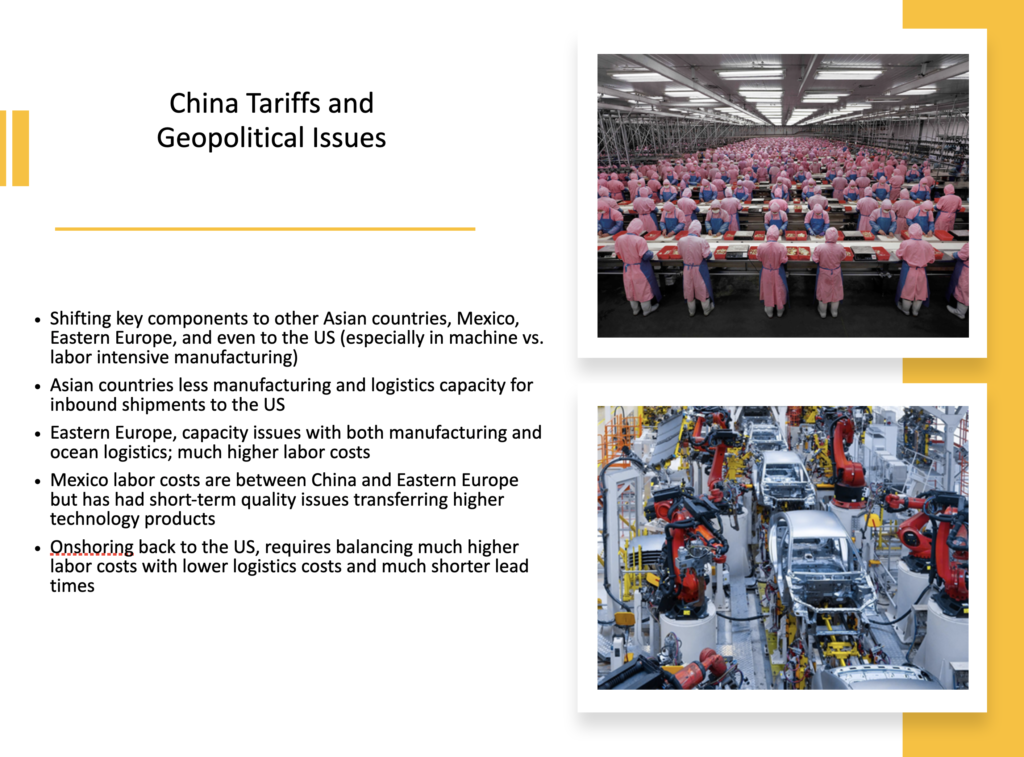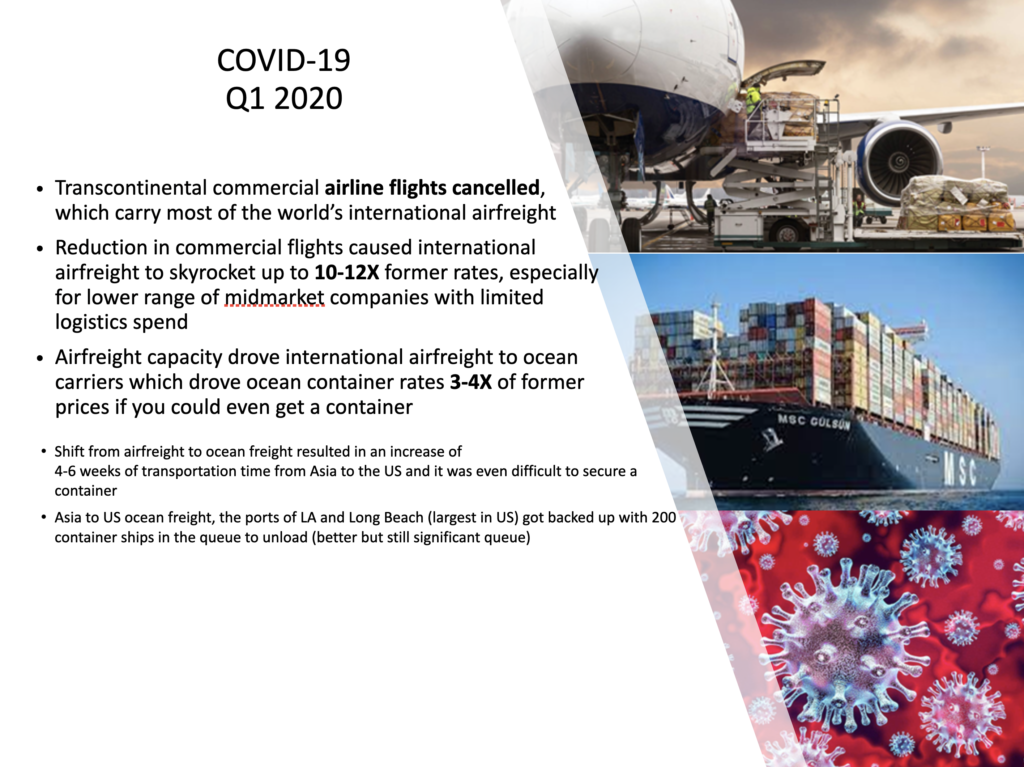What is supply chain disruption? Disruption as defined in the dictionary, “disturbance or problems that interrupts an event, activity, or process.” A supply chain disruption definition is a breakdown in the manufacturing flow of goods and their delivery to customers.
StockIQ’s clients voiced concern over supply disruption and wanted to hear what their peers were experiencing, and any workarounds being deployed. StockIQ clients joined Jeffrey Porter, StockIQ and Jerry Joyce, TriVista Consulting, for IQ Live – The Perfect Storm Causing Global Supply Chain Disruption. The virtual event focused on series of events that have led to supply disruption. International and Domestic Supply issues are dominating the headlines, wreaking havoc on distributors and manufacturing service levels.
China Tariffs & Geopolitical Issues
Before COVID-19, the China tariffs and other geopolitical issues with China caused many US companies to shift key components of their supply base from China to other Asian countries, Mexico, Eastern Europe, and even to the US.
Key challenges of sourcing:
- The other Asian countries had significantly less manufacturing capacity and less logistics capacity for inbound shipments to the US.
- Eastern Europe also had capacity issues with both manufacturing and ocean logistics and much higher labor costs.
- Mexico labor costs are between China and Eastern Europe but has had short-term quality issues transferring higher technology products.
- Onshoring back to the US, requires balancing much higher labor costs with lower logistics costs and much shorter lead times

COVID-19 in Q1 2020
A significant volume of transcontinental commercial airline flights was cancelled which carry most of the world’s international airfreight. The reduction in commercial flights caused international airfreight to skyrocket up to 10-12X former rates, especially for the lower range of midmarket companies with limited logistics spend.
The dramatic reduction in airfreight capacity drove a significant amount of international airfreight to ocean carriers which drove ocean container rates 3-4X of former prices if you could even get a container. The shift from airfreight to ocean freight resulted in an increase of 4-6 weeks of transportation time from Asia to the US and it was even difficult to secure a container.
Adding to the drama of Asia to US ocean freight, the ports of LA and Long Beach (the largest in America) got backed up with as many as 200 container ships in the queue to unload (it has gotten better but there is still a significant queue). The Suez Canal container ship log jam caused a major backup of over 400 ships that will take months from which to recover.
And to add insult to injury, all the above issues have also resulted in a significant portion of the world’s empty containers being in the wrong locations to support the world’s ocean freight demand.
Finally, there is uncertainty regarding the future of the China tariffs with the new administration, as well as an escalating “cold war” threat with China.
The above factors combined have wreaked havoc on global supply chains, the global logistics industry, and inbound transportation networks for US companies.

COVID-19 & Other Factors Impacting Domestic Supply Chains:
- COVID-19 drove a significant increase in domestic on-line purchases.
- Small parcel carriers (FedEx, UPS, etc.) have been overwhelmed with the dramatic increase in demand of on-line purchases and are now on a trailer allocation process with large shippers.
- Zone skipping of full trailers is the only way for some large shippers to get products shipped which their WMS and fulfillment processes do not support.
- LTL and FTL carriers are at full capacity and spot market rates can be 2X 2020 rates.
- Intermodal transportation is also at full capacity with escalating rates.
- On-line purchases caused major shift from palletized LTL freight to 1-each parcel shipments and many warehouse operations are ill-equipped to handle the transition.
- COVID-driven steel mill shutdowns and the China steel tariffs have resulted in a net shortage of steel and other critical metals with associated price increases to US manufacturers.
- The tremendous demand in electric vehicles and automotive technology in general along with the computer and gaming industries have resulted in a serious supply shortage of semiconductors and computer chips, causing many auto and technology plant shutdowns.
- Severe direct labor shortage in key regions due to unemployment subsidies paying up to $48K to stay at home.
All these factors in tandem have driven many supply chain and logistics disruptions and challenges, impacting many industries at multiple levels in their respective value chains.
Key Takeaways
Unfortunately, there aren’t any silver bullets, however, we have a few suggestions.
- This is a suboptimal time for negotiating long term freight contracts while rates are much higher than pre-COVID, including LTL, FTL, Parcel, and Ocean. Hold off on negotiating new contracts.
- Consider adding two (2) weeks of ocean transportation time and deliver to East Coast ports for eastern DCs.
- $ Newark is only about $500 more per container than LA
- Intermodal cross-country transport can be $5-7,000 per container
- If selling through Amazon but doing D-T-C fulfillment, consider moving to Amazon fulfillment utilizing their expertise in 1-each orders.
- Consider full truckload and zone skipping (helps bypass capacity limitations with FedEx/UPS) i.e., for large shippers, this is only way to get sufficient trailer capacity.
- Currently, for LTL and FTL shipments, the spot market often has better rates than contracted rates.
- StockIQ Overrides – Leverage transportation Lead Time overrides by vendor or item.
- Consider using StockIQ calculated Lead times based on 3 or 4 months of historical receipts.
In Summary, these are unprecedented times in global trade. Supply issues will likely dominate headlines through the Summer and Fall of 2021. It is prudent to prepare by adopting a heads up and hands on approach to consistently monitoring trends and the management of planning parameters.
Topic research and content provided by Jeffrey Porter, CMO with StockIQ and Jerry Joyce, Director, TriVista.
StockIQ delivers world-class inventory visibility solutions to companies across the globe. Our integration-friendly supply chain management suite plugs-and-plays with virtually all leading ERPs and WMS solutions on the market. We didn’t build StockIQ for C-level, bottom-level, or mid-level. We built it for everyone. With custom-coded dashboards and plenty of niche insights, StockIQ delivers value across your business architecture. Contact us to learn more.
